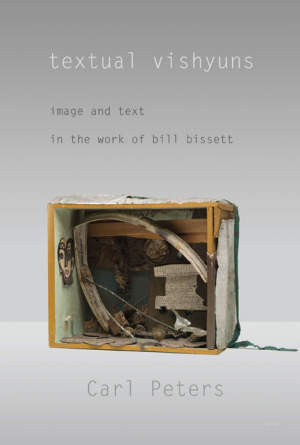By Sasha Moedt (The Cascade) – Email
Date Posted: November 2, 2011
Print Edition: October 26, 2011
 UFV professor Carl Peters has added to UFV’s body of contributions to the literary world with his recently published book on the works of bill bissett – the first critical analysis of its kind. textual vishyuns: image and text in the work of bill bissett is a study of the aesthetic significance of bissett’s visual arts, which Peters identifies as just as important in challenging the conventions of form as bissett’s poetry is; as bissett’s poetry challenges linguistic standards, his drawings, paintings, and collages challenge artistic standards.
UFV professor Carl Peters has added to UFV’s body of contributions to the literary world with his recently published book on the works of bill bissett – the first critical analysis of its kind. textual vishyuns: image and text in the work of bill bissett is a study of the aesthetic significance of bissett’s visual arts, which Peters identifies as just as important in challenging the conventions of form as bissett’s poetry is; as bissett’s poetry challenges linguistic standards, his drawings, paintings, and collages challenge artistic standards.
Peters specializes in poetry and avant-garde art, teaching English classes and Art History at UFV. He first became interested in bissett during his last year of high school, when he was given one of bissett’s books.
“On the back cover of that book was a full-figure photo of the poet,” he recalled. “It was blurred – like a Monet painting; it also reminded me of a Seurat painting. Or, I would soon discover, the poet’s own poems, which were unreadable. Something is going on in this image, I remember thinking.”
Using an interdisciplinary technique of analysis, Peters examined bissett’s work through the complex lens with which bissett writes. “bissett’s multi-media work, his whole art, demands a new critical vocabulary and this new critical vocabulary is an interdisciplinary critical vocabulary,” he explained, “so I have read bissett’s work through film; I have read his paintings through writing, not just his own, but modern and contemporary writing and philosophy, too.”
Peters has been occupied with this study for more than a decade. “It has taken that long to invent a critical vocabulary with which to read and do justice to his extraordinary art,” he said.
Originally having wanted to be a painter, Peters turned to writing after taking a contemporary art course that introduced him to conceptual art. “I became interested in artists who use language as their material,” Peters said, “I came to the insight that the most interesting work was interdisciplinary. Neither just one thing or another, but a combination of things. A new thing.”
bissett is a Canadian poet and artist. His work pioneers a form outside the standard, with an unorthodox and experimental style that draws controversy; he has a reputation for blowing conventionality out of the water.
Despite bissett’s status as a prolific writer, there is remarkably little detailed academic study of his art. Peters speculated that the reason for so little scholarly attention is because of bissett’s anti-academic methods.
“I think the reason… is because the work itself is so radically anarchic and avant-garde.” Peters explained. “bissett…breaks all the rules and academics especially may think he is beneath them. They do not take his orthography seriously and they may see it as an affectation. In actual fact, bissett’s syntax is a rigorous deconstruction into the inner-most alchemy of the word.”
As far as genre goes, Peters said he could almost place bissett in his own separate school, though his paintings can draw comparisons to other art. “In a way he reminds me of Picasso because he is so protean and prolific. He is always creating, always making something out of something else.”
bissett was inspired, in Peters’s opinion, by Gertrude Stein. “Stein taught bissett that language can exist independently of narrative. That is to say, not all writing has to follow from an intention or bring the reader to an idea or message. Writing can be a lot more open-ended than that; and the experience of reading this kind of writing rewarding—‘meaningful’—in itself.”
Stein was influenced by Picasso, as well as Matisse and Juan Gris – she studied their pictures carefully, and they gave her a critical language. In essence, Peters is convinced that accomplished painters are influenced by the best writers. “If you want to paint well you must learn how to read well. The same is true for writing well.”
Peters takes bissett’s style and puts in the scope of a larger context, of the history and practice of art. Equipped with theories, drawing from concepts of modern artists and poetics, Peters looks at bissett’s art through a lens of detailed and thorough academic diligence, but with creative insight that is necessary to delve into the mind of such an artist.
“The poet is there and not there. The art is there and not there. Great poets are like magicians explaining their best trick. And bill bissett is the greatest trickster I’ve ever read.”
Peters will be doing a reading of textual vishyuns: image and text in the work of bill bissett November 10. It will be located at the UFV bookstore on the Abbotsford campus, at 12:30.

